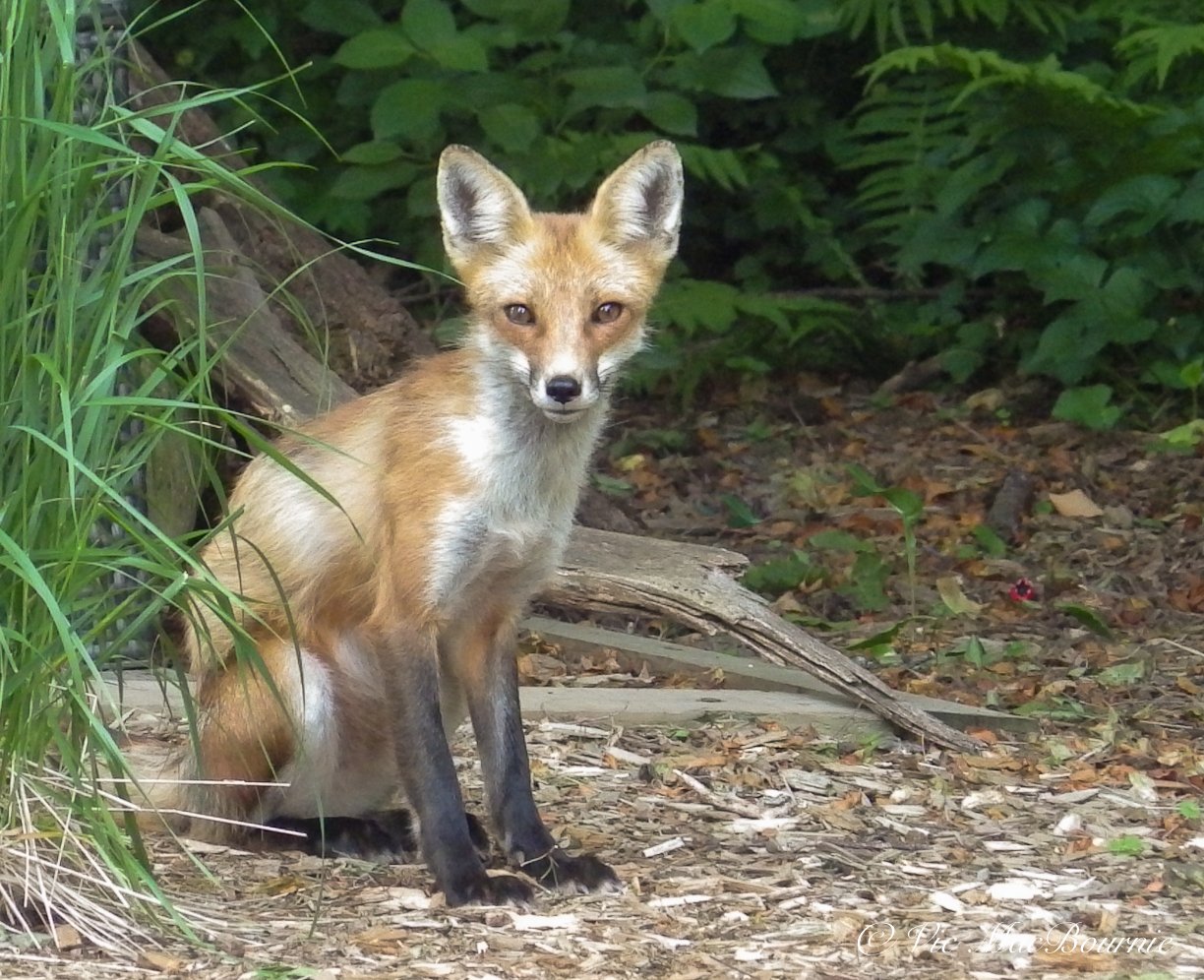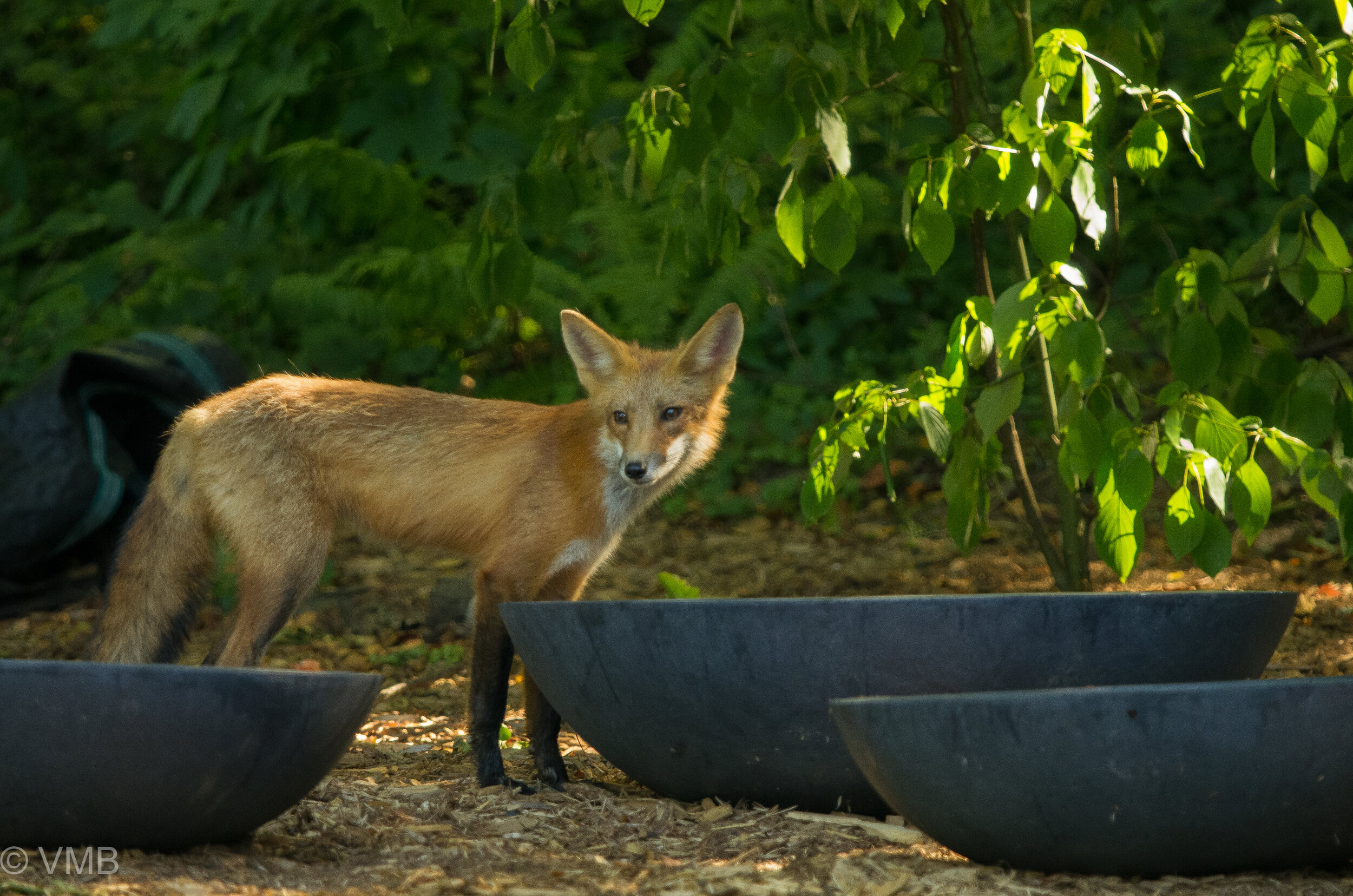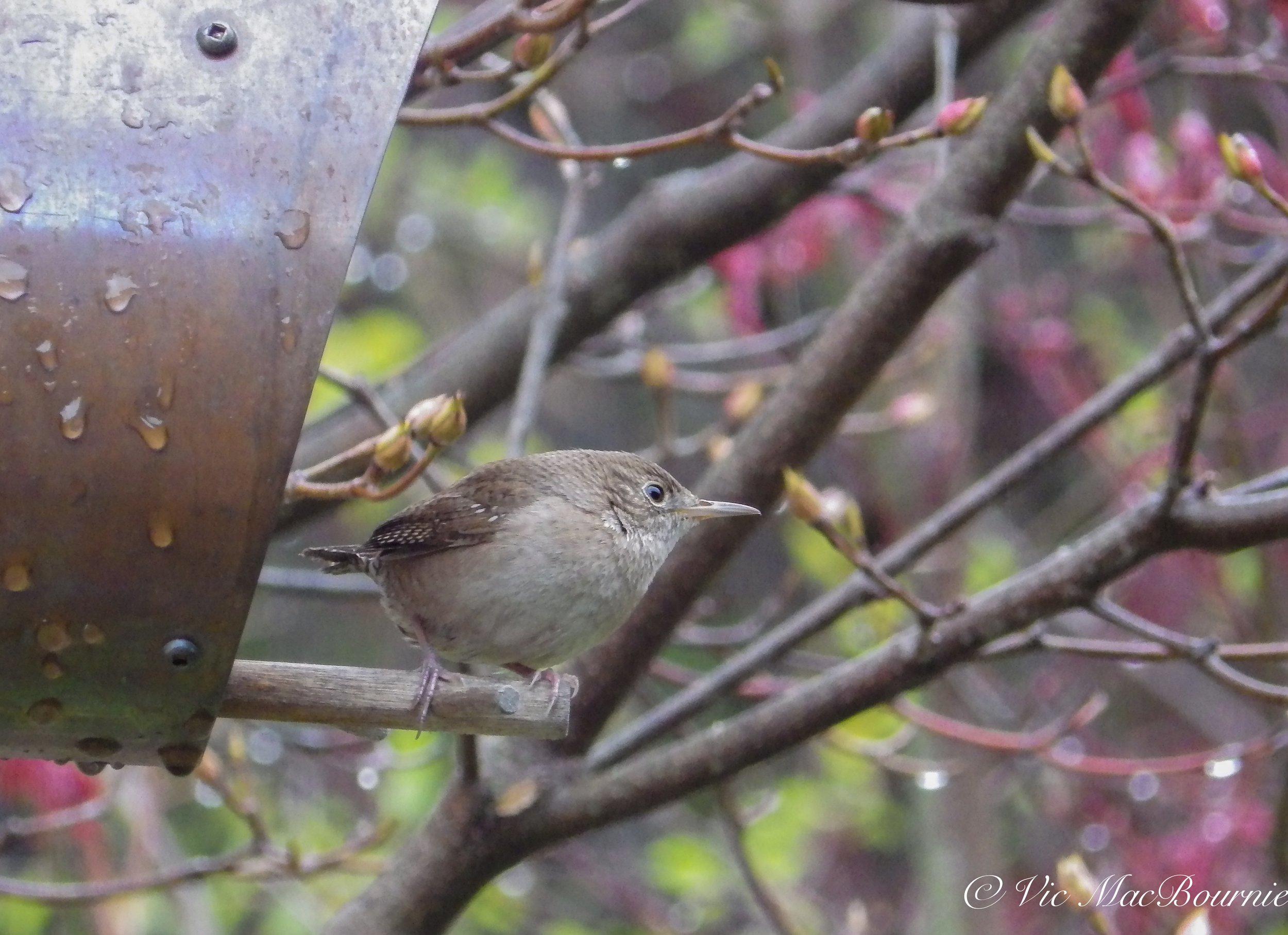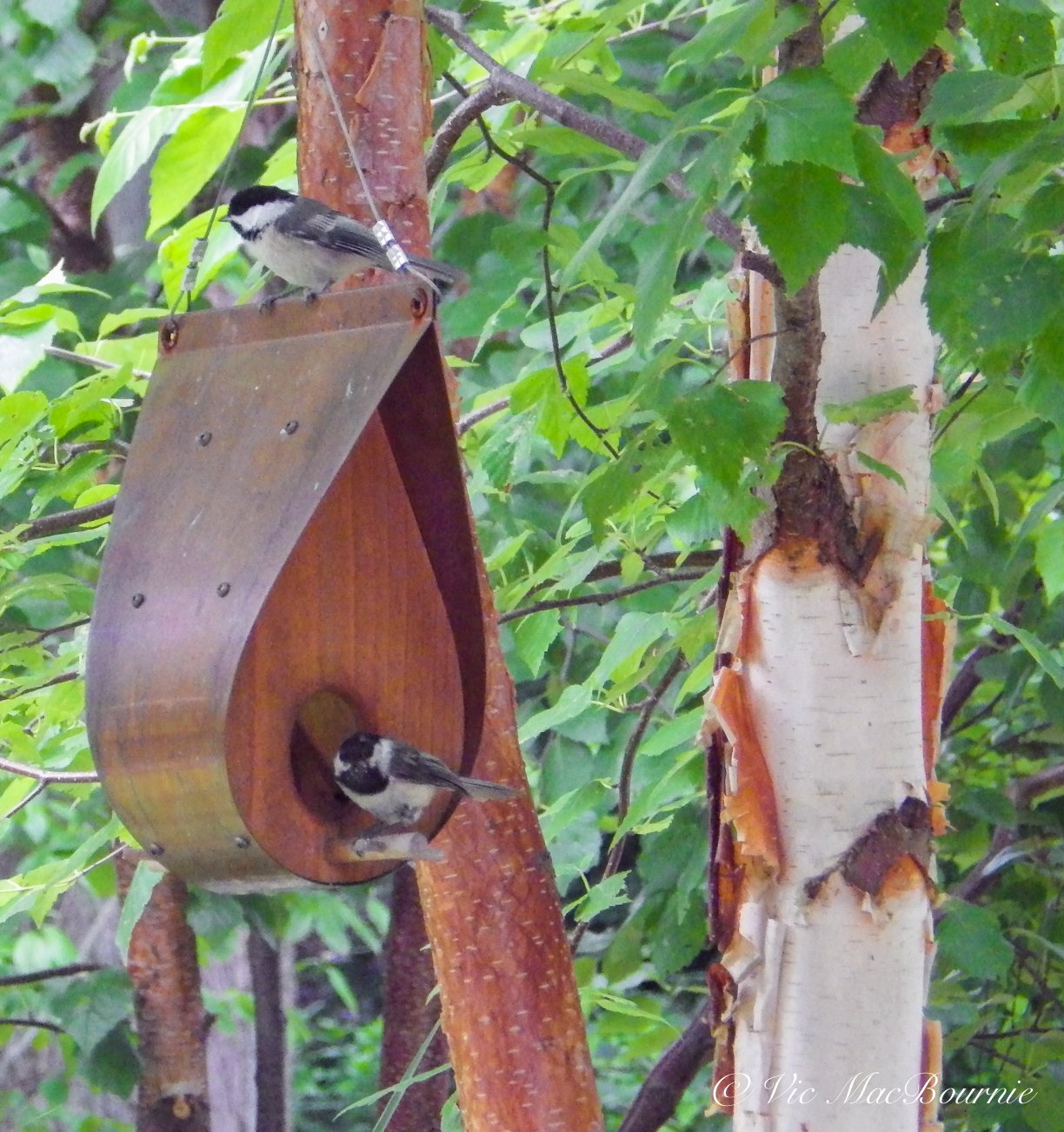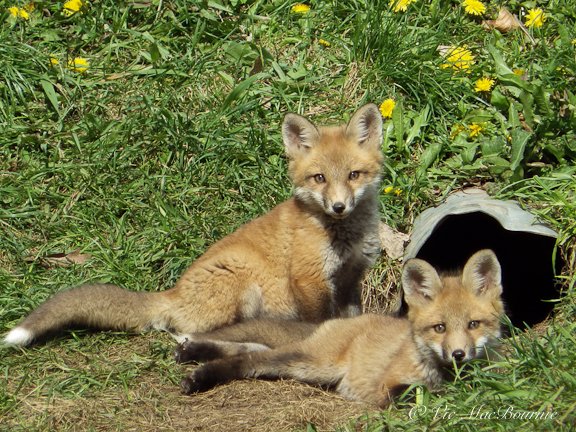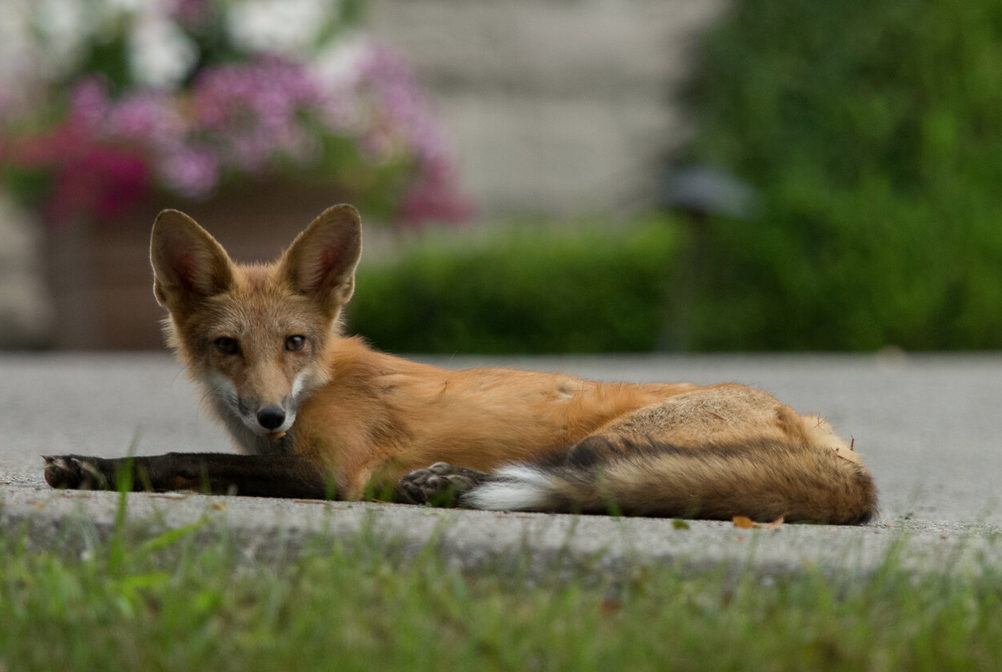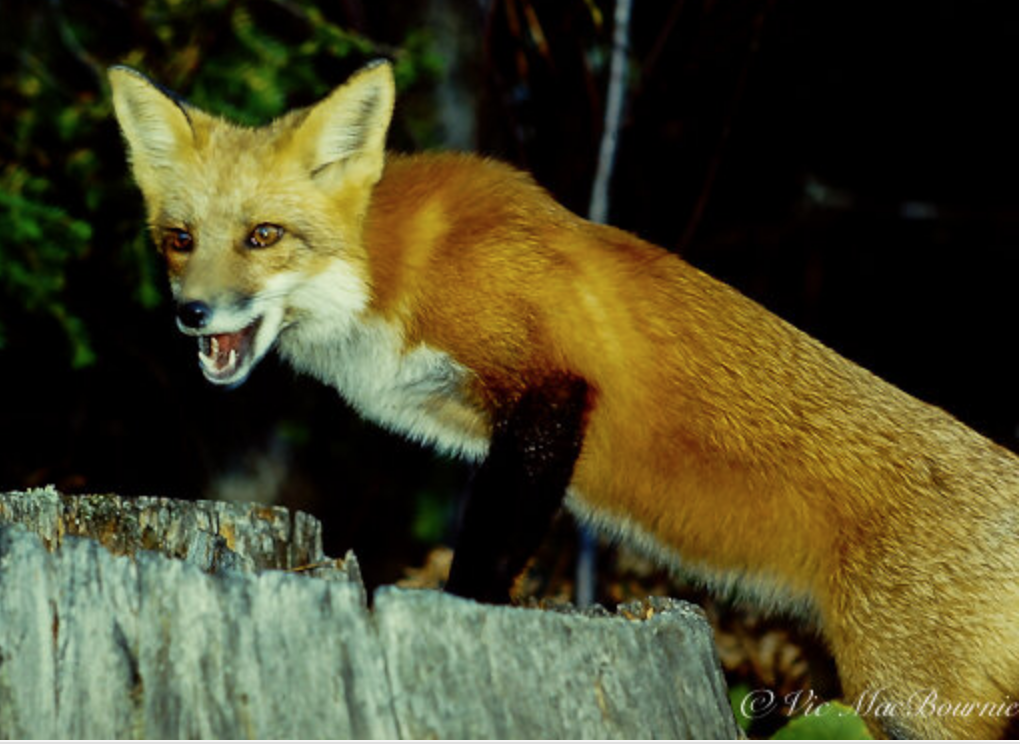Tips to photograph wildlife in your woodland garden
Creating the right environment to be successful in the garden involves a lot of hard work. But, in the end, it pays off. It’s not luck that you saw an oriole, a fox or hummingbird in your garden. It’s the result of that hard work you put in earlier to create the right conditions.
Bridge camera is great choice for garden photography
One of our neighbourhood foxes dropped in for its daily visit. It helped that I was armed with my camera on a monopod and my favourite lens.
This fox image is an example of how the right environment created an opportunity to capture an image that presented itself.
It began with a decision to work on getting a good image of a hummingbird feeding at a native Cardinal flower, but ended hours later with a memorable image of a fox.
Let me explain.
The cardinal flower was at its prime and I knew that, if I wanted to use it to get an image of a hummingbird feeding, I needed to act swiftly. So I set the camera on a tripod, filled up my coffee and waited.
(If you are interested in exploring garden photography at a higher level, be sure to check out my comprehensive post on the Best camera and lens for Garden Photography.)
If you are looking for a new camera or lens, check out B&H Cameras & Video for a complete line of cameras and lenses.
And, if you are wondering how a point-and-shoot digital camera that’s more than 10 years old can perform in the garden, be sure to check out my post on the Canon PowerShot Elph 500 HS.
The hummers came to the feeders surrounding the Cardinal flowers but only stopped at the flowers three times for a brief moment.
About three hours into the shoot, I noticed a fox standing by our shed looking my way. It was by no means stressed by my presence. In fact, it seemed perfectly happy to share the yard with me provided we stayed at a comfortable distance.
How often have you been in the yard and a great photographic opportunity presented itself to you? Too often, we are not prepared. Chances are, all we have is our smart phone by our side and the resulting image is nothing but a poor replica of a memorable moment.
But on this day I was in luck. The camera was already set up with my favourite 300mm F4.5 lens on a monopod.
I couldn’t ask for a better situation. Even our dog Holly had yet to notice the fox that trotted over to our three large water bowls and helped herself to a long drink.
A few quick bursts of photos from the 35mm DSLR camera and off she went. Like a ghost. There one moment … the next, gone. It was over as quickly as it began.
The lesson learned was simple: Be prepared.
Today, even if I just go out to enjoy my morning coffee, I always have a camera by my side ready for action. Sometimes it’s a simple “Travel camera” (read my travel camera review here) with a wide angle to short telephoto lens that is great for basic garden shots but will not likely get you close enough to most wildlife.
If you are looking to upgrade your camera equipment – be it a new camera body or lens – be sure to check out KEH Camera Exchange for the best prices on excellent used equipment. You can also trade in your used gear to help curtail the cost of new equipment.
Most likely, it is my versatile “Bridge camera” that allows me to shoot everything from long telephoto images of wildlife, including birds and butterflies, to sweeping wide-angle garden vistas, to macro shots of flowers and insects.
On this day, I happened to have my 300mm lens on the camera and ready to go, which made capturing the fox image possible.
This young fox decided to pose for me for a minute giving me time to focus the Pentax X5 “Bridge” camera to capture the image. I needed to use the full zoom power of the X5 (500mm) to capture the image.
More recently, however, I have a “bridge camera” with me. I have used the camera for more than a year now and have come to appreciate its versatility, with its ability to go from extreme telephoto to wide angle and even a very usable macro mode.
Bridge cameras, which are offered by all the major camera manufacturers, can be the perfect camera choice for garden photographers looking for a single extremely versatile camera that is at home photographing garden vistas as it is birds and other wildlife. Add to that versatility the ability to get in close to flowers for macro photography and it’s hard to believe that everyone is not lining up to purchase one. These cameras can be described as mid-priced cameras situated between a simple point-and-shoot and a more serious 35mm SLR with a complete line of lenses. Bridge cameras look like a typical digital single lens reflex (DSLR), but without the interchangeable lenses.
The bridge camera offers a built-in lens sporting a wide angle to long telephoto lens. The combination creates an easy-to-carry-around versatile camera that can deliver very good results with a little practise.
But they are not by any means perfect.
My bridge camera uses an electronic viewfinder in addition to the back LCD screen to view the image. The electronic viewfinder takes getting used to and falls far short of a optical viewfinder found in traditional DSLRs. To add to the difficulty of using the Bridge camera is a significant “shutter lag” meaning an excessive amount of time between when you press the button to take the image and the time it is actually taken. This shutter lag can mean the difference between getting the shot and missing it entirely.
In addition, because most of these cameras are so dependent on electronic viewfinders and the electronic zooming of the lens, some of these cameras tend to exhaust your batteries quickly, especially if you use the large back LCD screen as your primary viewer or to check your images regularly. My camera uses regular AAA batteries, which can be convenient when you are travelling, but compared to rechargeable batteries, can also be expensive to use. The other issue I have with the Pentax (which is no longer available) is the fact I cannot easily add filters to the front of the lens. This may not be a problem for most photographs, unless of course, you need to use a polarizing filter to remove glare from leaves or a pond.
Like most Bridge cameras, the Pentax X-5 bridge camera that I am using came with a very long 26X telephoto lens (the equivalent zoom for traditional 35mm cameras of about 22-580mm.) Most bridge cameras come equipped with a lens that provides the photographer with both a solid wide angle lens as well as a super-long telephoto lens.
Bridge cameras like my Pentax X-5 also come equipped with an impressive macro feature making it the perfect camera to carry with me into the garden for casual macro shots. For more serious macro photography, I will mount a 50mm or 100mm dedicated macro lens on a 35mm SLR camera.
Being prepared, having the right tools at hand and, of course, some luck on your side can mean the difference between getting the shot and missing it.
Even seeing wildlife, let alone getting good photos of them, depends on a lot of factors going your way.
Luck certainly plays a role in any shot, but I like to think that it plays a smaller role than most people think.
A macro image of a clematis taken by the Pentax Bridge camera the X5, on macro mode. This shows the versatility of the camera and its lens that is able to go from long telephoto (see above image of the Fox) to extreme macro without changing the lens.
Being out in the yard for more than four hours patiently waiting for the hummingbirds to cooperate creates the opportunity to be successful. Still, I was unsuccessful getting that shot of the hummingbird. Instead, I had to “settle” for the fox shot.
I like to think you create your own luck.
Setting out large water bowls meant to provide local wildlife with a fresh water source helped create that opportunity for the photograph.
Creating a natural garden, providing a source of natural food and moving water in the form of bubbling rocks and fountains, not using pesticides, having woodpiles … these all provide the right environment to getting the photograph, or the opportunity to observe the wildlife that call our property home.
PopPhoto website lists their favourite Bridge Cameras in this informative article starting with the best overall camera going to the Sony Cyber-shot DSC-RX10 IV, the Canon PowerShot SX70 HS as the best Wildlife camera and the Panasonic Lumix FZ80 as the best budget camera.
It doesn’t have to be a fox. It could have been a bird, a butterfly a reptile, or even a photograph of a beautiful tree or grouping of flowers.
The day before this shot was taken, I was trying to capture some photographs of birds enjoying my new solar-powered fountain, when a little chipmunk decided to hang out with me for a while. So I got “lucky” and was able to get some great shots of the chipmunk too.
Getting lucky is really about creating the right environment to get photographic opportunities and then taking advantage of these opportunities.
It’s the same in your everyday life. Put yourself in the best environment to succeed and chances are you will.
Getting up early, spending time in our gardens, getting up close and intimate with flowers. These all create the opportunities to be successful.
I’ll be out again soon working on getting the shot of the hummingbird at the cardinal flower. Maybe I’ll get “lucky” and the hummer will cooperate this time.
This page contains affiliate links. If you purchase a product through one of them, I will receive a commission (at no additional cost to you) I try to only endorse products I have either used, have complete confidence in, or have experience with the manufacturer. Thank you for your support. This blog would not be possible without your continued support.
Why do foxes scream?
Have you ever heard a terrifying scream at night in the garden or in a nearby woodlands? Chances are the bone-chilling sound was simply a red fox calling out for a mate. The piercing sound of a fox scream can shatter the peace of the woodland garden, but it is just one of the many vocalizations foxes make.
Terrifying screams ring out in Woodland garden
Have you have ever heard a fox screaming at night in the garden?
If you are unfamiliar with the sound, mark my word, it’s what horror movies are made of. Some describe it as a bone-chilling sound similar to a woman in distress. Others describe it as a child screaming in pain.
Despite the terrifying, high-pitched sound, it’s important to note that the scream is nothing more than a form of communication used by red foxes. The vocalization is one of a number foxes use. Rest assured they are likely not in distress, being attacked or fighting, although they could be warning another fox that they are in the area and to leave them alone.
The screams are often heard during breeding season in the spring. The scream is believed to be used by vixens (female foxes) to lure male foxes to them for mating, but males have also been known to let out screams occasionally as well.
Parent foxes with cubs may also use loud screams to warn off other foxes entering into their territory.
A beautiful young fox hunts for mice in the grass. Foxes have several vocalizations including a loud, piercing scream that can sound terrifying in the middle of the night in the woodland garden.
Foxes are territorial
Foxes can be very territorial and will aggressively defend an area from other foxes.
Their territory is very much dependent on the habitat but studies show that they have been known to hold territories as small as 0.2 square kilometres in urban areas where food is plentiful, to as high as 40 square kilometres in more natural areas. Each fox family group consists of a vixen (female) a dog (male) and their kits.
In areas where foxes are not hunted regularly, and there is plenty of food, a family group could consist of several adult offspring.
Because foxes are most active at night, you are likely to hear the screams late into the night, but as a video below shows, fox will scream during the day as well.
In my case, it was around midnight and, although the screams were clearly coming from the hedgerow in the back of the garden along a fence line, I never saw the culprit and had no idea what was causing the sound.
Check out my earlier article on the urban fox.
Fox screams are surprisingly loud
The sheer loudness of the scream made me think it was coming from a much larger animal than a fox, either a racoon or coyote.
I’ve heard a terrified rabbit, angry racoons in a battle and barking deer, but nothing is more terrifying than a single fox or, even worse, a couple of foxes running through the garden screaming at one another.
I experienced it recently while taking our dog out for her late-night bathroom break.
I was sure an animal of some kind was the victim of a predator.
There had to be at least two fox, maybe more, contributing to the raucous sound.
It wasn’t until recently that I was able to determine the exact cause of the sound. YouTube videos provided the answer. If you have know idea what a screaming fox sounds like, check out these videos.
Two fox kits sit outside their den waiting for mom to return. Foxes can be are very territorial, especially when they have kits to protect.
Here is what a fox scream sounds like
I was not fortunate enough to record the fox scream in the garden but I’ve included some links here that provides both an audio and visual (see second video) example of fox screams.
Here is a YouTube video of a couple running through a forest around 1 am. The author suggests that it may have been parents distressed after a coyote or owl made off with one of their kits. It’s possible, but it may also be that the adults were communicating either between themselves or with their kits.
Here is a fun video of a fox seemingly wanting to play with a friendly dog in the middle of the day and letting the dog know it was not impressed when it ignored the fox. The video is particularly good because you can see the interaction and see the fox actually scream.
More Ferns & Feathers article’s on foxes
Wildlife Rescue: The Year of the Fox
Wildlife Rescue: Volunteers key to Wildlife Rehab success
The Fox Den and how to find it in your garden
Why foxes steal from our gardens: Fox got my croc
The urban fox: Easy Rodent control on four legs
What other vocalizations do foxes make?
Foxes, not unlike our dogs, coyotes and wolves, use numerous vocalizations to communicate with other foxes and kits. Their vocalizations are not as varied as our family pets.
The most common vocalization from a red fox are a quick series of high-pitched, almost yippy barks. Studies have shown that the bark sequence can be used as an identification system by other foxes.
The bark and scream are quite loud so are the most often heard sounds from a fox, but their are a host of quieter vocalizations used when foxes are in close proximity.
Gekkering is a guttural chattering with occasional yelps and howls that is often used by adult foxes during aggressive encounters as well as amongst kits playing around the den.
Parents will also use a sharp bark as an alarm call to alert youngsters of potential danger.
Submissive foxes will, not unlike wolves and coyotes, often emit piercing whines that often become loud shrieks as they approach more dominant animals.
Why foxes scream: A conclusion
If you are out at night in your woodland garden or hear a load scream through an open window, chances are good it’s a fox communicating with a partner or warning another fox that it’s intruding on their territory.
Having fox in your garden is a positive sign that your property is working as a natural resource for a host of animals including predators that help to keep rodents under control.
Rejoice, in their presence and embrace the many benefits they bring to our properties. They are fascinating animals that mean no harm to our family including our pets.
There are many examples of foxes hanging out with cats and dogs and growing so accustomed to people in the garden that they will tolerate a close approach as they explore the garden.
Remember, though, that these are wild animals and not pets.
Don’t be surprised if they decide your garden is as much their garden as it is yours. And don’t be surprised, if shoes, garden gloves and other potential “toys” go missing.
Check out my earlier story about why foxes steal from our gardens.
Welcome the urban fox: The ultimate rodent controller
Urban foxes are common throughout North America and are important predators in the control of rodents in our woodland gardens. Here are tips to help gardeners encourage them and help them survive and prosper in our gardens.
Do fox control mice and rats?
Our first fox sighting came on Day 2 after moving to our new, old home some 22 years ago.
My daughter and I were out for a stroll in the woods surrounding our home when a fox appeared on the path right in front of us, looked at us and went on its way without a care in the world.
Not long after, a fox visited the backyard bird feeder where it scored a black squirrel pretty much on a daily basis for several weeks. Every morning at breakfast, my daughter and I would see the fox appear out of nowhere, chase down a squirrel across the yard, catch it, and with a hard shake immobilize it, before carrying it back to its den no doubt for its kits.
Needless to say our squirrel population was kept nicely in check with the Red Fox around.
While squirrel is certainly on their list of preferred food, there is no question that mice and other rodents make up a high percentage of a fox’s diets throughout the year, especially in urban areas. Studies show that urban fox feed predominantly on small mammals, particularly rodents like rats, mice and voles. Rabbits are also among their preferred food choice. Together, these can make up about 50 per cent of their diet.
Our cute little neighbourhood fox taking a rest on a driveway before an evening of hunting. July is a difficult time for fox, and it shows here in the fox’s skinny body .
Ever heard a fox scream. It’s terrifying but fascinating. For more on why foxes scream, check out my post here.
But then they pretty much disappeared for years. Foxes became rare around these parts, apparently decimated by mange.
But they’re back and I couldn’t be happier.
Not sure our local rodent population is as excited about their return as I am, however. Urban foxes help control small mammals, particularly rodents including rats, mice and voles. Squirrels and rabbits are also on the menu to a lesser degree.
This alone is reason enough for gardeners to love these little canines.
Check out my earlier articles on Why do Foxes Scream and Why Foxes steal from our gardens
We have been noticing foxes in the area again for the past two years. This winter I noticed a fox at a neighbour’s property in mid winter. It greeted my dog and I after we returned for a walk. It was in January, about the time of peak mating period. This is about the time these usually quiet little fellas become quite vocal often screaming and barking as the males roam the neighbourhood looking for partners.
When do fox begin breeding?
By February the females are pregnant and begin clearing out den sites in and around our gardens (under decks, sheds and large tree stumps).
Cubs are usually born mid-march, totally deaf, blind and in need of their mother’s constant warmth. By April the cubs emerge from their dens and start eating solid food. By May the den is an active place, especially at dawn and dusk when the parents are busy bringing the growing kits food.
This photo shows on of our neighbourhood foxes killing its prey after pouncing on it in the garden. It’s not a pretty site to watch but our gardens can be good sources of food for neighbourhood foxes.
What do foxes eat?
Foxes are actually extremely opportunistic, omnivorous predators. Besides rodents, Fox will happily feed on invertebrates, particularly various beetles, butterflies and moths as well as earthworms, grasshoppers and crickets. And those pesky garden snails and slugs are also on their menus. Spiders too, are on their list of good eats.
To a lesser degree, Fox will eat frogs and small snakes.
Birds also make up a large part of a fox’s diet, especially in the spring and early summer when foxes are feeding their hungry cubs.
Some foxes have even been known to climb trees in search of prey or fruits and nuts.
Fox kits hanging out a their roadside den.
In an urban garden, there is no doubt that bird feeders provide the perfect opportunity for a fox to easily satisfy most if its nutritional needs. Everything from rats and mice to squirrels, chipmunks and a host of birds gather around the feeder, often letting their guard down just enough to become dinner for the fox.
Being the ultimate opportunist, Fox will feed on whatever is abundant in your area. Whether that’s bugs or rats, the fox will play an important role in keeping populations in check.
Do fox eat worms?
A 1980 study showed that worms played a major role in a cub’s diet during August and September as the cubs, born in March, begin using their own hunting skills to catch worms. The study found that during some months, earthworms may account for more than 60 per cent of a fox’s calorific intake. The study estimated that it would take approximately 120 worms in a night to meet a fox’s caloric needs.
Do fox eat larger animals than mice and rats?
In other areas, hedgehogs, deer, otter, European badger, opossum, raccoon, porcupine, and even wild boar are on the menu. Fox remains have also turned up in their diets as have domestic cat, but many of these animals are expected to be the result of scavenging.
Do fox eat plants and berries?
It’s not all about meat, however. Fox will happily eat a range of plant material, especially fruits, both wild and cultivated. ( I have noticed that my blueberries are disappearing just as they begin to ripen.) Blackberries, raspberries, cherries, apples plums, grapes and even nuts are important foods for the fox as winter approaches. Studies show that fruit accounts for about 10 to 30 per cent of the diet.
And not unlike our domestic canines, grasses, sedges and various tubers find their way into the diet of most foxes.
For a more detailed look at the fox diet, go to Wildlife Online.
The main picture that accompanies this blog was taken at the end of July and it shows. At this time adult fox are often showing the strains of three months of having to provide for their growing cubs. It’s during this time that the fox begin to slow the feeding of their cubs and actually start competing for food with them. This is a dangerous time for the young foxes that are often forced to go out on their own to explore and fend for themselves.
If they survive, they begin to put on their winter coats in September and October in preparation for a long, hard winter. Male cubs leave the den area in late fall, early winter to look for their own territories.
And it all begins again.
How can the Woodland gardener help foxes?
It’s clear that providing a natural area, free of insecticides, that provides a combination of food sources including small rodents, fruit and nuts, while also providing water sources and potential den sites, is a goal all woodland gardeners should strive for. The brush pile we talked about in an earlier post becomes a hunting ground and a potential denning site for fox.
On-ground water bowls become a life-saving source of fresh water during a heat spell. Our humus-rich soil provides homes to insects and a source for earthworms. Leaving debris around the garden like branches and leaves give rodents like mice a place to live and, in return, a source of food for predators such as fox, owls and even snakes.
And, if our properties can only provide a few of these resources, we can provide a green island in a neighbourhood of green islands where a predator like the fox can exist.
We can be the ark (Acts of Restorative Kindness) that Irish landscape designer Mary Reynolds urges in her book The Garden Awakening and on her website, even if our gardens are small islands in a sea of islands.
Why do foxes steal from our garden? Fox got my Croc
Somewhere in my neighbourhood is a lost and lonely Croc. It disappeared during an overnight crime spree carried out with great stealth. Our dog saved one by her barking. I am worried about the other.
Closing in on the crime
Somewhere in my neighbourhood a lost Croc is scared, lonely and likely getting chewed on.
I rescued its sibling on a patch of parched earth in the middle of our lawn.
The saga began when I woke up, looked out back to ensure it was safe to put Holly out for the morning. Just two days earlier, she got skunked and I wasn’t going to let that happen again.
(You might want to check out my other articles on foxes: Why Foxes Scream and The urban fox and how it controls rodents like mice and rats.
In the middle of the lawn, what looked like a dead squirrel lay motionless.
Earlier, Holly had been barking at the window. I imagined the barking scared the fox who dropped the squirrel. I went outside to move the dead animal.
Young foxes like to use “toys” such as shoes and gloves to learn life skills including catching prey.
When I stepped out the back door I noticed my old Crocs were nowhere in site. I remember leaving them just outside the door after watering the garden the night before.
Barefoot, I walked out to the middle of the grass. There it sat, motionless. My old Croc, all alone in the parched grass. No doubt, left there in haste by our friendly neighbourhood fox on its regular morning visit.
This wouldn’t be the first time a fox decided to take something that was not theirs. Foxes have been known to make a habit out of stealing people’s shoes. In fact, some have even become famous for their shoe fetishes.
Take the shoe-loving foxes from a neighbourhood in Japan that pilfered 40 pairs of sandals before being nabbed in the act of the crime after a six-hour police stakeout.
This fox is hunting for mice in a grassy area of the garden.
The pair of sly foxes were discovered after police received reports of footwear mysteriously disappearing from eight households in Nagaokakyo, about 235 miles (380km) west of Tokyo.
Five police officers were involved in the stakeout that ended with the discovery of two foxes who had made their home in the garden of an empty house, with 40 pairs of shoes scattered around a burrow.
In a German town, a fox was responsible for stealing more than 100 shoes.
In England, 50 shoes were found along a path near a fox den – runners and work boots seemed to be the favourites.
So I am not alone. My Croc joins a long list of missing shoes stolen from yards while their owners slept soundly in their beds, totally unaware of the crimes happening all around them.
What makes them want to take our shoes?
From a website on foxes: “A wide range of objects can be found close by a breeding den – besides pieces of paper, plastic and bone there is an array of leathergoods like chewed shoes, gardening gloves or balls. Fox cubs have used them to play with. These “toys” are apparently presented to the young cubs by adult foxes. Later, older cubs bring them back from their own adventure tours.”
The same site describes how fox cubs use the “toys” to play with their siblings and use various “objects to train their hunting skills such as how to catch and handle their prey.”
So, some advice to my fellow gardeners: Don’t leave shoes, including your favourite Crocs or gardening gloves (especially leather ones) outside overnight. Consider putting away any other articles that you think might be a score for the neighbourhood fox.
We don’t need any more orphaned Crocs.
Be sure to check out my other articles on foxes: Why Foxes Scream and The urban fox and how it controls rodents like mice and rats.

